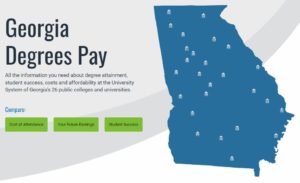By Lance Wallace
ATLANTA, Ga. | The University System of Georgia (USG) is launching a new tool to help students and families work through critical decisions about college affordability and value.
The new website, Georgia Degrees Pay, provides an array of public data on Georgia’s 26 public colleges and universities. It allows comparisons about the overall cost to attend college, majors and fields of study, average student borrowing and average career earnings of USG graduates.
The comprehensive website features a link to USG’s “Find Your School” web page, where potential students can enter information about themselves and a list of USG institutions that meet their criteria will be generated for them. Georgia Degrees Pay also includes links to information about scholarships, online degrees, online courses and student support efforts such as Complete College Georgia, Affordable Learning Georgia and eCampus, among others.
The tools were developed by the Carl Vinson Institute of Government at the University of Georgia in collaboration with members of the USG Research and Policy Analysis and Communications teams.
Each tool allows users to compare colleges and universities on an array of statistics. For example, in the cost of attendance tool, users can compare tuition and mandatory fees, total cost of attendance, average scholarships and grants and net price.
They can also find student loan outcomes such as the percentage of students who borrow each year, the average amount borrowed each year, the percentage of graduates who have any debt from pursuing their bachelor’s degree, the average amount borrowed among bachelor’s degree graduates, the percentage of graduates who have any debt from pursuing their associate degree, average amount borrowed among associate degree graduates and the loan default rate for graduates.
 The website’s new future earnings tool allows users to see the average earnings of USG graduates in Georgia after they receive their degree, as well as earnings for different majors, earnings by alumni from different institutions and a range of earnings by academic area for one, five and 10 years after graduation.
The website’s new future earnings tool allows users to see the average earnings of USG graduates in Georgia after they receive their degree, as well as earnings for different majors, earnings by alumni from different institutions and a range of earnings by academic area for one, five and 10 years after graduation.
The student success tool gives users the ability to compare the makeup of the student body at two institutions as well as the percentage of students who continue into their second year, the percentage who graduate and how long on average it takes them to finish their degree. The tool also compares the percentage of Georgia students who earn and retain Georgia’s renowned HOPE and Zell Miller scholarships.
For the best results with the comparative tools, users are encouraged to compare institutions from the same sector. USG’s 26 institutions fall into four general sectors – research universities, comprehensive universities, state universities and state colleges – each with unique missions, requirements and academic programs to meet a range of student needs across the state.
- Have a comment? Send to: elliott@brack.net










Follow Us